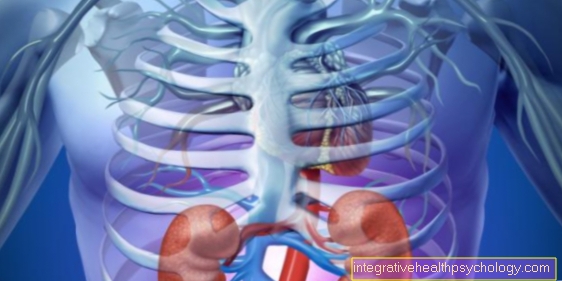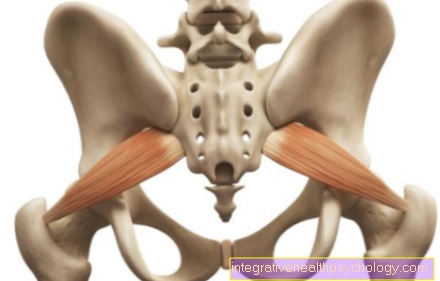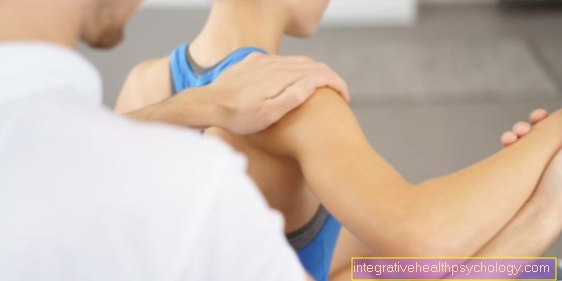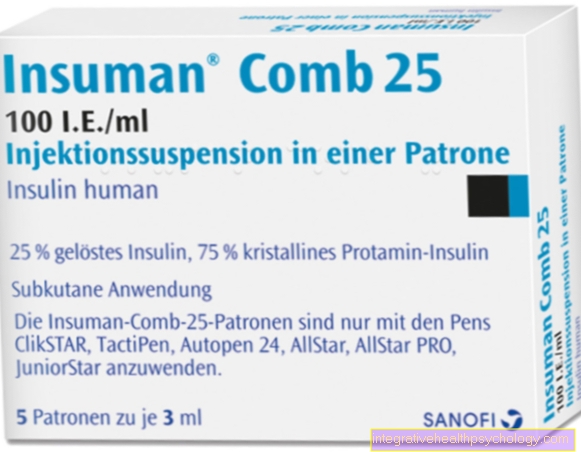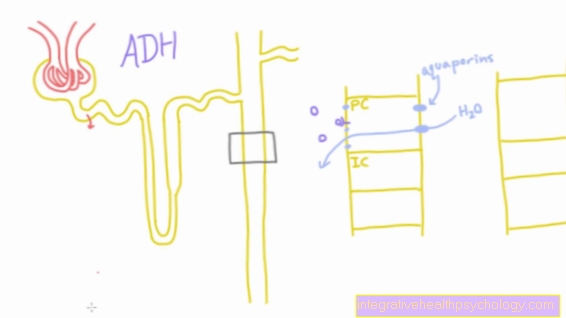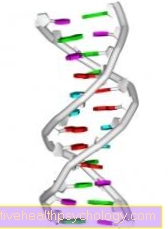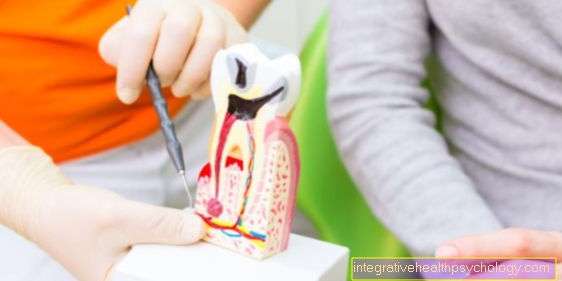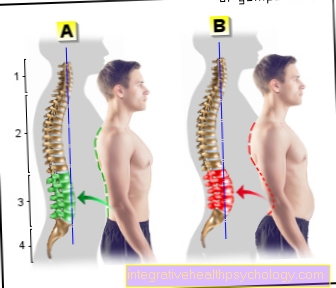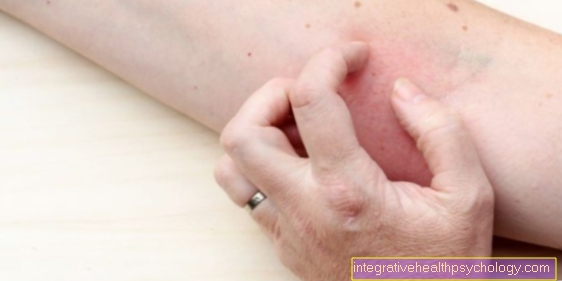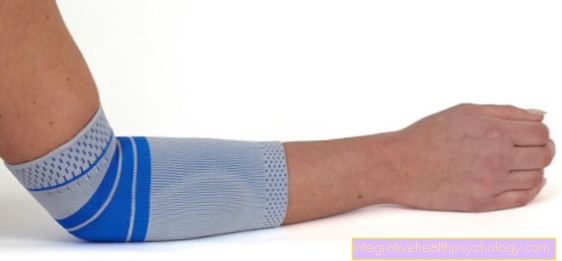Piriformis muscle
Synonyms
German name: pear-shaped muscle
definition
The piriformis muscle is a pear-shaped muscle that belongs to the deep hip muscles.
It helps, among other things, the external rotation, the splay and the backward movement of the leg.

Course of the piriformis muscle
The Piriformis muscle arises on the inner surface of the Os sacrum (sacrum), more precisely from the foramina sacralia anteriora (sacral holes) one to four.
In addition, some fiber strands arise from:
- the upper edge of the major ischial notch
- from Sacrotuberous ligament
and - the Articulatio sacroiliaca
It then runs through the greater ischial foramen (ischial hole) and attaches to the Thighbones, more precisely on the inside of the apex of the Major trochanter (Tip on the large rolling mound).
This is where the muscles come in too Musculi gemelli and Obturator internus muscle together.
Illustration piriformis muscle

Piriformis muscle
- Pear-shaped muscle -
Piriformis muscle - Iliac scoop -
Ala ossis ilii - Posterior sacrum holes -
Posterior sacral foramina - Sacrum -
Sacrum - Great Rolling Hill -
Greater trochanter - Small rolling hill -
Lesser trochanter - Thigh shaft -
Corpus femoris - Ischium -
Os ischii (ischium) - Fifth lumbar vertebra -
Vertebra lumbalis V
You can find an overview of all Dr-Gumpert images at: medical illustrations
Pain

The piriformis muscle runs in close proximity to the exit point of the sciatic nerve from the inside of the pelvis to the back of the buttocks. In some people, the sciatic nerve even pulls through the piriformis muscle, which promotes the development of sciatic pain through this muscle. If the piriformis muscle shortens or thickens, for example due to incorrect or insufficient training or limited mobility of the hip due to joint problems, the sciatic nerve is compressed and either pressed against the bony pelvis or pinched in the muscle fibers.
This pressure on the sciatic nerve results in so-called pseudoradicular pain, which is pain that is very similar to the symptoms of a herniated disc, but is not caused by a problem with the intervertebral discs.Pain caused by the pressure of a thickened piriformis muscle on the sciatic nerve or the entrapment of nerve fibers in the thickened piriformis muscle is also known as piriformis syndrome.
Overloading or poor posture can also trigger the piriformis syndrome through an inflammatory reaction. Inflammation of the piriformis muscle can lead to an accompanying inflammation of the surrounding tissue. Since the sciatic nerve near the piriformis muscle is located, it can also be affected by this inflammatory response and forward pain impulses to the brain. Sharp pains in the lumbar spine and deep buttocks can be symptoms as well as long-lasting pain that radiates into the leg on the affected side or a tingling sensation that spreads over the buttocks and back thigh. In severe cases, standing on tiptoe and heels may be restricted.
Piriformis syndrome can cause pain when climbing stairs, cycling, jogging or lying on the sick side. Sitting for longer periods of time can also increase the pain, because in a sitting position not only does the piriformis muscle irritate the sciatic nerve, but the weight of the body also leads to additional compression of the sciatic nerve. Crossing your legs while sitting makes the pain even worse.
Read more on the subject below Symptoms of Piriformis Syndrome.
Piriformis Syndrome Test
For detecting a piriformis syndrome there is no test, unfortunately, can prove with absolute certainty that the pain from the piriformis muscle can be triggered. However, there are various tests for piriformis syndrome that can be combined with high probability lead to proof or exclusion of the syndrome.
The so-called FAIR test the patient lies on the healthy side, the leg lying down is being stretched out and the upper body in the best possible laid flat on the examination table. The leg on the painful side is pulled towards the body with the knee bent so that the hip is flexed 60° amounts. Additionally this leg will adducted and internally rotatedThe knee is oriented towards the examination table. The examiner now pushes the overhead leg further down towards the couch and thus releases one strain of the piriformis muscle. Pain in the buttocks during this examination indicate piriformis syndrome. The FAIR test is also positive when can be triggered only by pressure on the buttocks over the area of the piriformis muscle pain in the buttocks in the examination position. The FAIR test is a very sensitive and specific test for the piriformis muscle, but it can of course also be positive for other diseases of the lower back and buttocks.
For more information, read our topic Tests for Piriformis Syndrome.
stretch
The piriformis muscle runs from the Sacrum to the greater trochanter of the Thighbone. Regular stretching can relieve pain caused by the piriformis muscle. The stretching exercises relax the pelvic area and the pressure from the tense piriformis muscle is released. The piriformis muscle acts in the External rotation of the leg, but can also be used with the Spreading the thigh or the leg to the rear to lead.
The best way to stretch it is to assume a position achieved by movement mediated by the piriformis muscle. One way is to sit down on his knees and then stretch one leg back so that it contacts with the kneecap to the ground. This position will stretch the piriformis muscle and should be held for about a minute. There are 2-3 repetitions per side.
Another stretching exercise is done lying on your back. The knees are bent so that the soles of the feet are firmly on the floor. Then one leg is pulled up towards the upper body and one foot is brought to the knee. The leg to be stretched crosses so the other leg. Now push the knee of the leg to be stretched away from the body and hold the position for about a minute. Here, too, 2-3 repetitions are useful.
Exercise the piriformis muscle
The piriformis muscle conveys one through its contraction External rotation, Abduction (Splay) and Extension (Extension) in the hip joint. All of its functions are used well by both large and small Glutes exercised, which is why special training is difficult only for the piriformis muscle. Strengthening exercises that use the entire Strengthen the buttocks muscles and thus prevent functional impairment of the piriformis muscle. Exercises for the Abductor group of the thigh as well as exercises for the Hip musclesAs these Muskelgrupppen stabilize the pelvis and correct bad posture, which is also a cause of piriformis syndrome can be.
function
As mentioned briefly above, the small piriformis muscle many functions.
He:
- turns the leg outwards (External rotation)
- stretches the leg (Extension)
- spreads it to one side (Abduction)
- and leads him backwards (Retro version)
Innervation
The nervous is taken care of Piriformis muscle from Sacral plexus.
The sacral plexus is a plexus of nerves in the sacrum and is made up of the L5 and S1 nerves.
Diseases
The great Sciatic nerve runs between the Piriformis muscle and the pelvic bone in the infrapiriforme foramen.
In the event of an accident, the Sciatic nerve through the M. piriformis and thus to the Piriformis Syndrome come.
A rarely known phenomenon is the L5 / S1 in a herniated disc Trendelenburg sign can come.
In one occurring through a L5 / S1 disc herniation most physicians think directly to problems on the lower legs, so the Fußhebern (M. tibialis anterior = anterior tibial muscle, extensor hallucis longus) and core of the foot (M. gastrocenmius = calf muscle / twin muscle).
The Trendelenburg sign ensteht to stand on one leg because the pool can not be sufficiently abducted by the paralysis of the piriformis muscle and the resulting disability. The consequence of this paralysis is a waddling gait.
Piriformis Syndrome
Muscles have to be innervated by nerves, i.e. controlled. In the case of the piriformis muscle, this happens via direct nerves from the Sacral plexus. The sacral plexus is a large plexus of nerves that lies on the sacrum.
Piriformis syndrome describes one Narrowing of the sciatic nervewhich runs through the infrapiriforme foramen. The sciatic nerve originates from the sacral plexus and supplies the hip, thigh, lower leg and foot muscles. Can cause the constriction jerky, vigorous movements the hip, one wrong posture, an injury or even long periods of sitting be.
It comes to as a result of this severe lower back pain, in the buttocks and in Thigh. In some cases it even extends into the groin, on the front of the body. Also Sensory disturbances such as tingling or numbness are possible. The symptoms often occur when the hips are rotated, i.e. when you turn your upper body to the side or turn over in bed.
Treatment usually consists of one Exercise therapy, stretching and Exercises to build strength in the muscles of the buttocks and thighs. In addition, massages and in extreme cases anti-inflammatory pain relievers how ibuprofen help. You can treat the pain relatively easily, effectively and cheaply and thus reduce it. Nevertheless, the therapy should be taken seriously, as it can otherwise lead to serious consequences such as difficulty walking.





.jpg)

